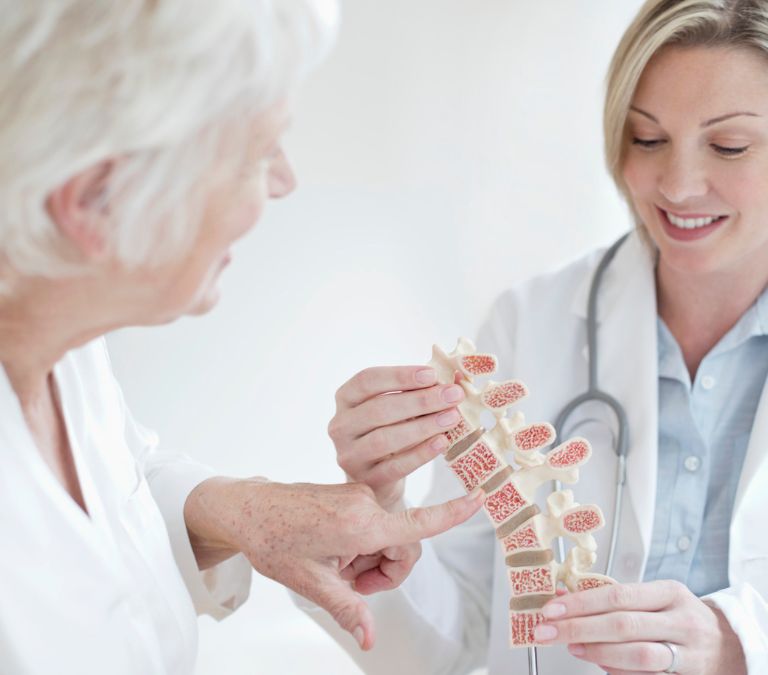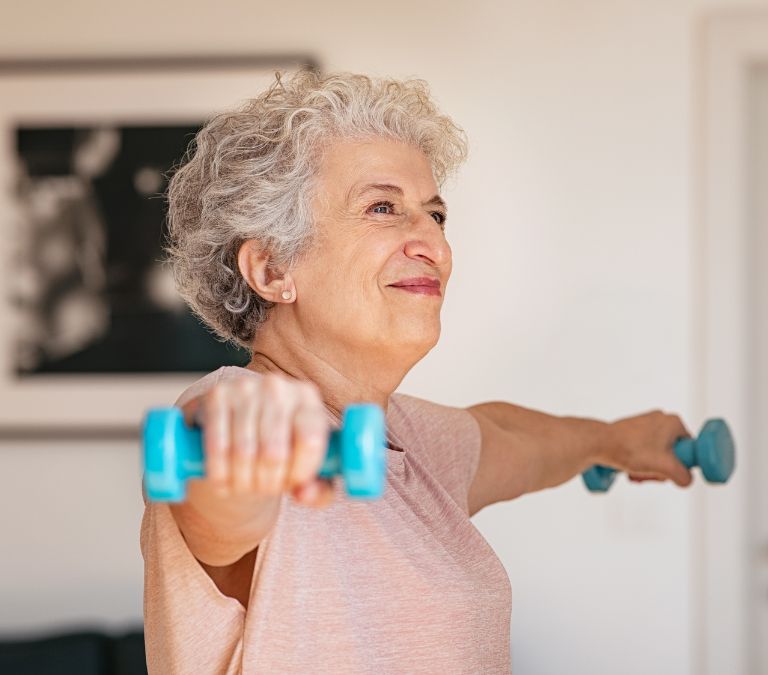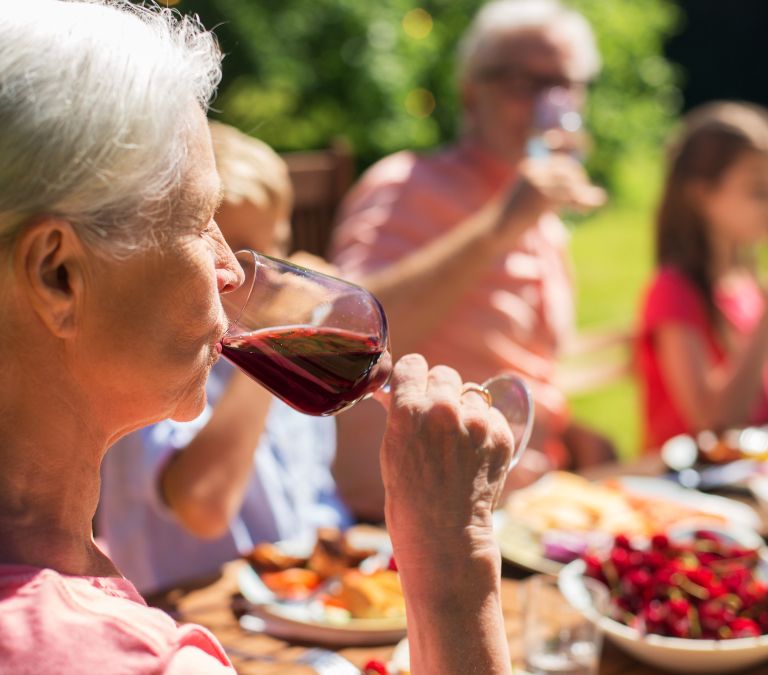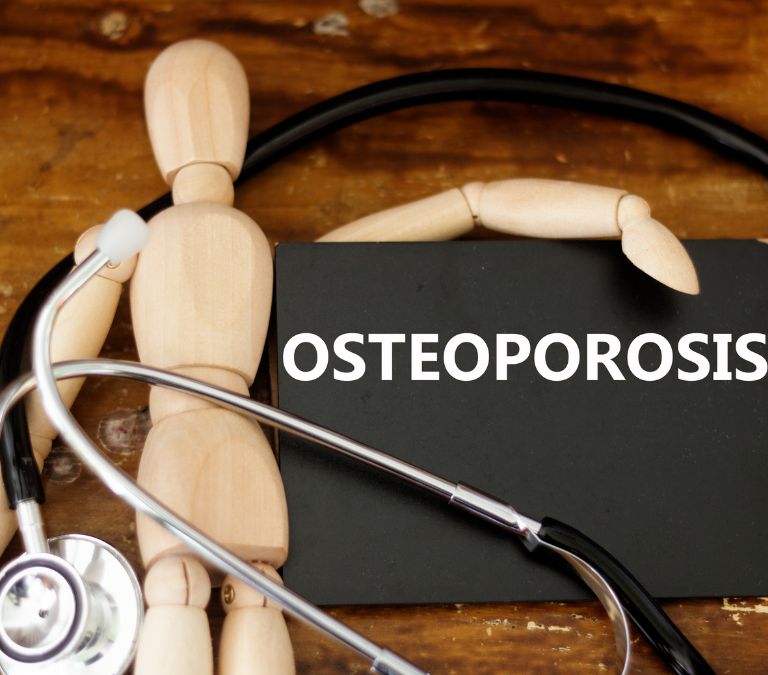Osteoporosis is a common symptom of aging; every living person will experience osteoporosis as they grow older. However, menopause acts as a catalyst for osteoporosis in women. When your natural menstrual cycle ends, your bones lose their density and can fracture easily.
Naturally, you start losing bone density from age 35. That is why professional athletes often retire in their late 30s; their bones are slightly depreciating, and they can’t handle as many intense workouts as they could in their early days.
Even though we have established that osteoporosis affects humans in general, bone loss develops during menopause. Women experiencing menopause lose many hormones responsible for maintaining their body function.
Symptoms like sleep disorder, stress, hot flashes, chills, etc., are common with menopause, but osteoporosis is a symptom that has a lasting effect on the body. According to studies, a woman can lose up to 20% of her bones during the 5 or 7-year span of menopause.
As your estrogen levels drop during menopause, the risk of osteoporosis increases significantly. While many experts put out tips and tricks to help evade osteoporosis during menopause, it is still a symptom you will inevitably experience.
We all know the phrase “prevention is better than cure.” But how do you prevent or even cure what you have no idea about? The best way is to gather as much information as possible and put it into practice.
Suppose you’ve been searching for a complete guide to menopause and osteoporosis. In that case, this article will enlighten you about the relationship between menopause and osteoporosis and give you five helpful tips to help you increase your bone density. Let’s go!
How Does Menopause Cause Osteoporosis?

While we know that osteoporosis is a common symptom of menopause, narrowing down the causes of osteoporosis in menopausal women is pretty hard. Many factors, like aging, family history, ethnicity, etc., cause osteoporosis in women.
The bone cycle of humans takes a pretty unusual trend. You have very feeble bones at birth, and your bones reach max density as you grow into your teenage or youthful age. According to studies, women reach their peak bone density between ages 25 and 30; from 30 and above, you start experiencing bone depreciation.
However, the effects of osteoporosis appear quicker in women, largely due to menopause. It doesn’t indicate that menopause is a direct cause of osteoporosis in women, but it contributes significantly to the sickness.
Menopausal women experience peak menopausal symptoms between ages 45 and 55. During this period, your estrogen levels are in a constant depreciation state. Lack of estrogen is a major symptom of menopause in women and can lead to other secondary symptoms like hot flashes, chills, depression, etc.
Suppose we are to narrow the effect of estrogen to menopause and, ultimately, osteoporosis. In that case, you could say that estrogen is one of the most important hormones in women – at least until menopause kicks in.
Estrogen is the hormone responsible for reproduction in women. As you enter menopause, your estrogen and progesterone levels reduce drastically. Hormones like estrogen help in regulating your bone metabolism.
When your estrogen levels are high, your bones benefit from osteoporosis by maintaining bone structure. When your estrogen levels inevitably reduce due to menopause, your bones are left porous and vulnerable to osteoporosis.
Estrogen isn’t meant for reproduction alone. It also influences the flow of osteocytes in the body, a cell lying in the substance of a fully developed bone. When your estrogen levels are low, cells like osteocytes lack the nutrients to function properly, making it hard for them to maintain your bone structure.
Since estrogen helps bone-related cells in your body, like osteocytes, function properly, a decrease in its availability will certainly lead to a few defects in their responsibilities, i.e., osteoporosis.
Therefore, we can conclude that menopause doesn’t directly cause osteoporosis; rather, the symptoms associated with menopause, i.e., a drop in estrogen levels, can cause osteoporosis.
However, a drop in estrogen levels isn’t the only cause of osteoporosis. Other menopausal symptoms and secondary factors combined with estrogen drop can cause osteoporosis to develop faster in menopausal women.
What is the Fastest Way to Increase Bone Density
Menopause is an irreversible phase that every woman experiences in due time. Once you start experiencing menopausal symptoms, they become almost irreversible. No matter the treatment’s cost or intensity, most of the symptoms you experience will likely stick around for a while.
However, the steps and actions you take during menopause determine the severity of the effects of your menopausal symptoms. Hormone therapy could help reduce the symptoms but not eliminate them; you can only reduce their effects.
In this section, we will show you some of the five of the fastest ways you can use to increase your bone density. They are:
- Exercise
Exercise is one of the easiest and most natural ways to build your bones. Whether you are experiencing menopause or not, exercise has been proven over and over to build bones.
During osteoporosis, your bones fracture, and the effects spread quickly during menopause. While you might be tempted to use medical solutions like mental hormone therapy, exercising daily for as little as 30 minutes can significantly reduce the risk of osteoporosis during menopause.
According to research statistics, about 1 in three women in North America has osteoporosis. This figure will only increase if you fail to exercise regularly. In general, having a relatively dull exercise routine can increase your risk of bone loss.
Many experts recommend exercise as the go-to option for women who are not ready for medical treatment for osteoporosis. When you exercise, you not only increase the strength of your bones but also maintain the density of your bones over time.
If you want to exercise during menopause, there are a handful of routines you can practice without causing more damage to your bones. Of course, you don’t want to go to the gym lifting dumbbells used by professional athletes, but you can practice exercises that fall into these categories:
- · Weight Bearing
- · Flexibility
- · Resistance
-
Weight Bearing
Weight-bearing exercises involve workouts that major in support of your feet to your body’s total weight. These types of exercise aim to do one main thing; increase the density of your leg bones.
Some common weight-bearing exercises include walking, hiking, stair climbing, dancing, etc. Any exercise involving you using your feet is a weight-bearing exercise.
However some people might include bicycling and swimming as weight-bearing exercises, but this isn’t the case. Both exercises are great for dealing with heart and lung problems, but they have little impact on improving your bone health.
On the other hand, doing exercises like walking or hiking can help build your bone health. The number of steps you take daily also determines the impact level of your routine. Generally, experts recommend taking at least 12,500 steps daily to help reduce the risk of osteoporosis.
-
Flexibility
Flexibility exercises help in stretching out your joints and bones. Most times, bones fracture due to the stiff nature of the bones. Examples of flexibility exercise that helps improve your bone density are Yoga, T’ai Chi, and even regular stretching.
- Resistance
Resistance exercises are routines that pit your weight against the weight of an object. Resistance exercise helps improve the strength of your bones and muscle. Common resistance exercises that can improve your bone density include free weights, e.g., dumbbells, babbles, kettlebells, etc.
Resistance exercises need to be done repeatedly. For example, if you’re lifting a dumbbell, you can start with beginner sizes like 2lbs, 5lbs, and 10lbs. When you’ve got your desired starting weight, experts recommend taking on this workout 2 to 3 times weekly.
What Determines your Exercise Routine

It’s important to want to exercise, but not every exercise routine suits everyone. Before you take on any exercise routine, be it resistance, flexibility, or weight bearing, ensure you consult your physiotherapist or doctor to help you decide on the perfect exercise.
Nevertheless, here are some factors that you should consider before exercising:
- Age
- Underlying health problems
- Medications
- The severity of your osteoporosis
Before you take on your desired exercise routine, ensure it’s fit for your age and will not elevate your symptoms of osteoporosis.
Eat a Healthy Diet
It’s common knowledge that calcium is the major mineral responsible for bone health and formation. When you undergo menopause, a lot of your hormones, minerals, and vitamins alike will reduce and causes bone deficiency.
Eating diets rich in depleting hormones can not only improve your bone health but also helps in improving your other menopausal symptoms. If you have been eating healthy before menopause, your risk of osteoporosis reduces significantly compared to a woman who has lived on a pretty unhealthy dietary plan.
As you grow older, your bones will experience bone metabolism; it is a natural phase in the life of every human. During this process, your bones are constantly broken down and rebuilt simultaneously by two cells – osteoclasts and osteoblasts.
However, when such cells become affected by menopause due to the loss of estrogen, your bone metabolism becomes unbalanced. Osteoclasts are responsible for breaking down the old bones, and osteoblasts form new bones.
When you eat healthily, such cells responsible for bone metabolism acquire the right nutrients and can help them function properly. If you are aiming to increase the density of your bones, here are a few nutrients and foods you’re required to have in your daily dietary plan:
- Calcium
If your main purpose is bone appreciation, calcium is a nutrient you don’t want missing in your dietary plan. In general, calcium deficiency is responsible for the majority of bone-related illnesses in people.
Teens and young adults must have about 1,300 milligrams of calcium daily to improve their bone health. However, for adults, especially those over 50 years, males and females require about 1,000 milligrams and 1,200 milligrams, respectively.
You notice that women over 50 years require more calcium than men the same age. The reason is that the menopausal factor sets in and can easily deplete the amount of calcium available in your body due to continuous hormonal decrease.
Examples of food filled with calcium include oatmeal, milk, tofu, sardines, baked beans, and many more. If you wish to improve your bone health, ensure your diet has an extensive allocation of calcium.
- Protein
Protein is another beneficial nutrient you want to have in your daily diet. If you are deficient in protein and calcium, you have a greater risk of osteoporosis. If you eat food that contains a sufficient amount of protein and calcium, you can greatly improve your bone health.
Examples of protein-rich foods include meat, fish, eggs, beans, soy products, and many more.
A healthy diet is a two-way process; it involves the food you should eat and what you should avoid. You should avoid categories of food to ensure that your diet remains healthy.
- Caffeinated Foods
When you drink excess coffee, your body excretes nutrients at a pace quicker than normal. Caffeine is sometimes used to clear the system, so if you take excess regularly, your body will excrete more urine than the body requires.
People should drink not more than three cups of coffee daily. Drinks containing colas should also be regulated to avoid excessive nutrient excretion. When you regulate your coffee, the calcium deposit in your body remains as long as the body needs it, thereby improving the health of your bones.
- Foods with Excess Salt
According to studies, excessive salt intake can fast-track calcium excretion in your body. If you are experiencing osteoporosis, limiting your salt intake (processed and cooked food) is a good idea to improve the calcium deposit in your body.
Reduce your Alcohol Intake

Chronic alcohol intake compromises the health of your bones. Heavy drinking during adolescence can increase your risk of osteoporosis. Calcium is the major nutrient responsible for bone health, and alcohol is a very vile enemy of calcium.
Alcohol affects calcium absorption, and excessive intake can cause your bones to deteriorate faster than normal. Excess alcohol intake hinders the body from digesting nutrients like calcium. Alcohol also affects the liver, which is also involved in calcium absorption.
In your menopausal years, taking excess alcohol is not recommended. Taking as little as three ounces of alcohol daily during menopause can greatly affect your bone health. Some studies suggest that excess alcohol intake reduces estrogen levels and can slowly cause osteoporosis.
There are two major bone-damaging hormones in your body; cortisol and parathyroid hormone. When you take excess alcohol, these bone-damaging hormones increase drastically. When you have too much cortisol in your body, your bones find it hard to form; instead, they break down faster.
Regulating your alcohol intake can help you cope with osteoporosis, but if you want to see quicker and more visible changes, quitting will help your bones recover rapidly.
Quit Smoking

Smoking has already been proven to cause several chronic diseases, such as cardiovascular disease, chronic pulmonary disease, and many more. Smoking tobacco can temporarily render your bones imbalanced, thereby leaving your bones vulnerable to osteoporosis.
Tobacco also influences the estrogen levels in your body; it interferes with the normal metabolism of your bones. Even though scientists are constantly inventing modern ways to smoke tobacco, like e-cigarettes and water pipes, they still have the same effects on the body, just on a lower scale.
Constant tobacco intake alters the body weight of smokers. To have a healthy bone weight, your body mass index (BMI) and body weight must be equal. Most smokers have lower body weight and body mass index compared to non-smokers.
Most smokers indulge in smoking due to depression, which might be understandable, but the adverse effects of smoking greatly outweigh the negative effects. If you smoke and are experiencing osteoporosis, you should quit. Quitting smoking helps your bones heal properly.
Get Enough Vitamin D
Vitamin D is another secondary nutrient that helps in bone metabolism. Bones utilize Vitamin D to improve your calcium absorption rate. Your body also uses Vitamin D to relay messages throughout your body.
Vitamin D is gotten majorly from the sun. However, most people don’t still get enough sunlight. You might have jobs that keep you out of the sun throughout the day, or you’re just a stay-at-home mom. Whatever the reason is, lack of vitamin D reduces your bone health.
If vitamin D is so important, how much vitamin D should you get daily? Your daily vitamin F dosage depends largely on your age. For kids, experts recommend getting about 4000 IU of Vitamin D to maintain bone health, but 2000 to 3000 IU daily is okay.
However, older adults, especially menopausal women, need to get at least 600 IU of Vitamin D daily to reduce their risk of osteoporosis.
If you require 600 IU of Vitamin D, how can you get it? The most common way of getting Vitamin D is from the sun. When the sun shines directly on your skin, your body converts the sunlight to vitamin D.
To get the right dosage of Vitamin D, you need to stay in the sun for about 10 to 20 minutes daily without sunscreen. If you apply sunscreen to your skin, you will need to stay in the sun for longer.
However, it’s important not to overdose on your Vitamin D intake because excess exposure to sunlight can cause skin cancer. On very hot days, applying sunscreen will help regulate the amount of sunlight that can reach your skin.
Aside from sunlight, you can also get vitamin D through food intake. Fatty foods like salmon, fish, mackerel, etc., are great vitamin D sources.
Too much Vitamin D can cause your appetite to decrease. You might start peeing too much, experience nausea, and even weight loss. Therefore, you should take the Vitamin D needed to improve your bone health and avoid overdose.
Can Osteoporosis Be Reversed after Menopause
Osteoporosis isn’t like most menopausal symptoms. Things like depression, stress, and hot flashes can be treated using several medical and natural ways. If you follow your medication judiciously, you might completely eradicate these symptoms.
However, osteoporosis affects bone health, making correcting or reversing the changes much harder. The short answer is no; Osteoporosis cannot be reversed after menopause and is not curable either.
Bones function like honeycombs; there are little holes as the comb develops. When you have osteoporosis, such holes become bigger, causing your bones to fracture due to the growing size of such holes.
You can’t cure osteoporosis, but you can make some adjustments to your lifestyle, eating habits, and exercise routine. Some might argue that medical hormone therapy can correct the adverse effects of osteoporosis, but they are not entirely correct.
Major hormones like estrogen and progesterone decrease when women undergo menopause. Since estrogen helps with bone metabolism, a lack of it can cause osteoporosis.
However, since estrogen contributes to bone metabolism, hormone therapy will not cure osteoporosis but can improve the estrogen levels in your body. The frequency at which you take hormonal therapy has to be regulated because if you try to replicate the number of hormones you had at your younger age, you might be doing more harm than good.
Hormone therapy is great for women who want to reduce menopausal symptoms like hot flashes, depression, stress, etc., but it is not an absolute cure for osteoporosis.
You can improve your bone health by exercising, eating healthy, going out for some Vitamin D, and many more natural ways.
Conclusion
You have a higher chance of beating osteoporosis if you make significant changes to your lifestyle. Osteoporosis will still affect either stage if you’re experiencing menopause or in your post-menopausal phase.
The best way to reduce the risk is to follow your doctor’s prescription and implement some of the tips we discussed today.
For those searching for a complete guide to osteoporosis, I believe we’ve done our part to provide you with a comprehensive guide to menopause and osteoporosis.
Stay healthy!







